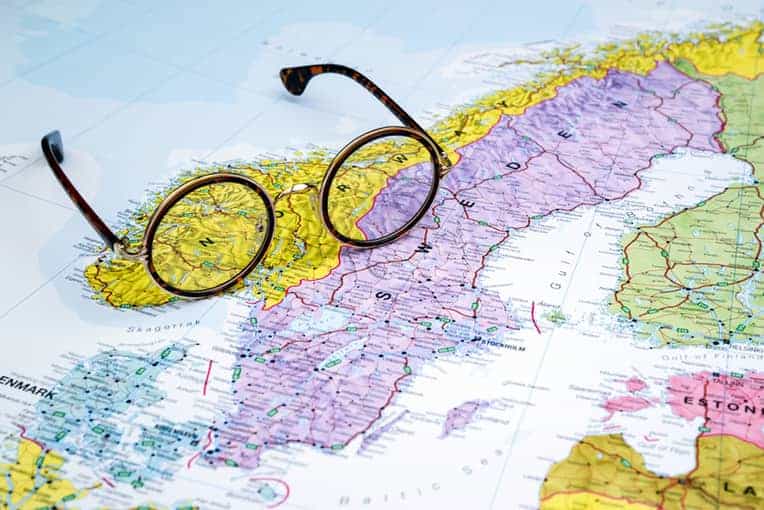The countries in the region of Scandinavia are some of the least populated nations in the world.
The countries that traditionally make up “Scandinavia,” which include Norway, Sweden, and Denmark, have fewer people living per square mile or kilometer than most countries in the world.
There are multiple reasons why Scandinavia is less populated than the rest of the world.
One reason relates to how people originally settled in the region, and the history that followed as a result.
Another reason regards the obstacles people encountered in the physical environment, like mountains, snow, and water.
In relation to the broader use of the term Scandinavia, which includes Finland, Iceland, and the Faroe Islands, there are even fewer people per square mile or kilometer.
The region of Scandinavia is one of the happiest places on Earth. See Why Are Scandinavian Countries So Happy? to learn more.

Scandinavia’s early history
Historically, Europeans from the south settled in Scandinavia, like various German people groups and their ancestors.
These early visitors did not travel into the far north of Scandinavia, in part because there were indigenous people who saw them as a threat to their way of life.
They first settled in Denmark and southern Norway, and Sweden. Meanwhile, the north remained less populated.
Challenging terrain: Another reason that prevented more settlements in the far north was the climate and the natural environment.
Though the northern regions of Scandinavia today have milder climates due to the Gulf Stream from the Atlantic Ocean, that was not always the case.
Ice and snow prevented easy settlements in the far north and made population growth in those regions slow. Other geographical factors like mountains, lakes, and rivers also presented challenges.
Migrating North: The industrial age in the 20th century enabled growth in northern Scandinavia. In this period, as one historian describes it, there was a chain reaction that resulted in more people in northern areas:
“With industrialization came improved transportation, first in the form of railways and then automobile highways.
The former developed a relatively dense network in Denmark and the core areas of Norway, Sweden, and Finland, but only wide spaced tentacles in the areas of northern” Scandinavia. [1]
The “tentacles” into the north matured over time, allowing people to move more freely from southern Scandinavia to the northern parts of the region.
The history of countries like Norway, Sweden, and Denmark is fascinating. See When was Scandinavia Founded? to learn more.

Population density of Scandinavian countries
Population density is a measurement that counts the number of people living in each unit of area, such as a square mile or square kilometer.
All countries in the world can be measured with regard to their population density.
- On one end of the population-density spectrum, are countries like Monaco, which has over 49,000+ people per square mile or 18,000+ people living per square kilometer and Singapore, which has 20,000+ people living per square mile or 7,000+ people living per square kilometer.
- On the other end of the spectrum are the least population-dense nations, such as Greenland, which has .08 people living per square mile or .03 people living per square kilometer and Mongolia, which has 4.9 people living per square mile or 1.9 people living per square kilometer.
Though the data varies slightly, partly based on what places (e.g. islands, territories) are considered “countries,” the nations of Scandinavia are mostly on the least-populated end of the spectrum when compared to other countries in the world.
Norway
Norway is also among the top 25 least-populated countries. It is 125,000+ square miles or 323,782 square kilometers. It’s population is 5,300,000+.
Its population density is 41 people per square miles or 16 people per square kilometer. [3]
What about the future? “A growth of immigration has also helped to swell numbers however and the CIA World Factbook estimates that current levels of growth will take the population of Norway to 7,032,687 by the year 2060.” [4]
Finland
Finland is similar to Norway. Finland is 130,000+ square miles or 338,000+ square kilometers.
Its population is 5,500,000+. Its population density is 41 people per square mile or 16 people per square mile. [5]
What about the future? “Current projections believe that the growth rate will get down to 0.10% by 2050 and that the population of Finland will be 5,580,127 in 2020, 5,739,095 in 2030, 5,813,529 by 2040, and 5,866,350 by 2050.
Regardless of the change in growth rate, the actual change in population will not vary by much.” [6]
Sweden
Sweden is in the top 50 according to most measurements. Sweden is 173,000+ square miles or 450,000+ square kilometers.
Its population is 10,300,00+ people. Its population density is 60 people per square mile or 23 people per square kilometer. [7]
What about the future? “The slow annual growth rate in Sweden is expected to continue slowing but at a very gradual pace. Current projections believe that in the years to come, the rate will reach a peak in 2020 at 0.72%, before decreasing towards 0.4% by 2045.” [8]
“Compared to current European standards, Sweden has a relatively high fertility rate measured at 1.9 births per woman. However, this has decreased from the rate of 1.99 births per woman in 2011. Most of the increase in population growth can be attributed to the increasing number of immigrants and live births in the country.” [8]
Denmark
Denmark is the most densely-populated Scandinavian country. It is closer to the most-populated end of the spectrum than the least-populated end.
The reasons for this are mostly historical. Early settlers found the resources they needed in the land of Denmark and did not have a need to travel north, where obstacles awaited them.
Depending on how the data is organized, Denmark usually ranks around the 60th to 70th most densely populated country in the world.
Denmark is 16,000+ per square miles or 43,000+ per square kilometers. It’s population is 5,800,000+ people. Its population density is 350 per square mile or 135 per square kilometers. [5]
What about the future? “Denmark has provided steady figures throughout its history and although the population growth is slow and sometimes negative from year to year, it is normally steady and fairly reliable.
The organization that is Statistics Denmark should, therefore, show that the population should breach the six million mark for the first time within the next ten years.
These projections believe that the annual growth rate will decrease from 0.38% in 2020 down to 0.19% by 2050. During this same time period the population of Denmark is expected to be 5,796,800 in 2020, 6,024,516 in 2030, 6,192,283 in 2040 and 6,314,402 by 2050.” [10]
Iceland
Iceland is among the top 10 least populated countries. It is 39,682 square miles or 102,775 square kilometers.
Its population is over 360,000. It has 9.1 people living per square mile or 3.5 people living per square kilometer. [1]
What about the future? “Iceland is expected to continue its steady growth, potentially hitting 493,000 by 2060, exceeding half a million for the first time by the second half of the 21st century.” [2]
The Faroe Islands
The Faroe Islands are among the top 75 least-populated countries in the world, which is still closer to the least-populated end of the spectrum than to the most-populated end.
The islands are 540 square miles or 1,300+ square kilometers. Its population is 50,000+ people.
This makes its population density 88 people per square mile or 34 people per square kilometer.
What about the future? The annual growth rate of the Faroe Island is expected to be less than .5% per year for the next 50 years, with the population growing by approximately 5,000 people in total. [9]
Scandinavia is one of the most fascinating places in the world. See The Scandinavia Peninsula: 16 Facts? to learn more.
Scandinavian people live near cities: Like elsewhere in the world, Scandinavia is experiencing more and more people moving to urban areas.
Though significantly smaller than the most populated cities in other European countries, the ten most populated cities in Scandinavia are:
- Stockholm, Sweden: 2,269,060
- Copenhagen, Denmark: 1,295,686
- Oslo, Norway: 1,281,127
- Helsinki, Finland: 1,138,502
- Göteborg, Sweden: 504,084
- Århus, Denmark: 336,411
- Malmö, Sweden: 312,012
- Bergen, Norway: 280,216
- Espoo, Finland: 256,760
- Tampere, Finland: 234,441
Population growth of Scandinavia
The population of Northern Europe is growing, numbering approximately 27 million people today. Norway leads the way with 12.3% growth. Iceland is second with 10% growth.
Sweden is third with 9.7% growth. By 2030, the population of Scandinavia is expected to reach 30 million people.
The growth is characterized by multiple factors:
- Immigration: Scandinavia has gained more people than it lost in the last 20 years as students, refugees, and others have relocated to the region. Sweden is the most popular Nordic country for refugees, followed by Norway and Finland.
- Urban growth: Major Scandinavian cities are expected to grow by 10% by 2030. Younger generations are driving the urban growth with motivations like going to school and working.
- Way of life: Many people around the world envy the way of life of Scandinavian countries. They read about studies reporting on the happiness of people in Norway, Sweden, and Denmark, as well as their health care system, which some find appealing.
Countries like Denmark, Norway, and Sweden are sometimes referred to as Nordic, but what does that mean? See Is Scandinavia Nordic? to learn more.
References:
[1] Source
[2] Source
[3] Source
[4] Source
[5] Source
[6] Source
[7] Source
[8] Source
[9] Source
[10] Source
